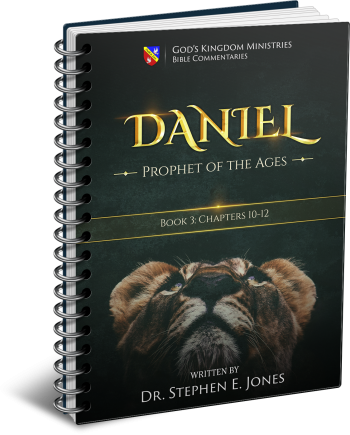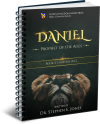Latest Posts
View the latest posts in an easy-to-read list format, with filtering options.

This is a commentary covering the last three of Daniel's visions in chapters 10-12.
Category - Bible Commentaries

The tenth chapter of Daniel records a vision and revelation that the prophet received during the third year of Cyrus. Daniel 10:1 begins by saying,
1 In the third year of Cyrus king of Persia, a message was revealed to Daniel, who was named Belteshazzar; and the message [dabar, “word, speech, message”] was true and one of great conflict, but he understood the message and had an understanding of the vision.
The “message” is said to be “true and one of great conflict.” The word for “true” is emeth, which is a three-dimensional Hebrew word that means “faith, God’s faithfulness, and truth.” Faith and truth come from the same Hebrew word, because true faith is believing the truth. No matter how strongly one believes a lie, it is not biblical faith. Faith comes by hearing the word of Christ (Rom. 10:17).
The word from the angel was also “one of great conflict.” In fact, as we will see, the angel had little or nothing to say insofar as Daniel’s inquiry was concerned. The main revelation passed down to us was how spiritual forces withstood the angel of God for 21 days. The spiritual conflict pictured two armies fighting in heaven, and this fact seemed to preempt the message itself.
Can you imagine yourself waiting for a messenger to arrive, and when he is late, he comes to tell you how and why he was unable to arrive sooner? Then he turns around and says, “Well, I have to get back, because other enemies are coming!” Hey, wait! What was the original message? So it is with the tenth chapter of Daniel. However, the actual prophetic message is given to us in chapter eleven.
The date of this vision is somewhat uncertain, because it depends on one’s point of view. Was this the third year of Cyrus after Darius had gone home to Media? More likely, it was the actual year that Darius went home after reorganizing the kingdom. When Cyrus took over from Darius and issued his decree allowing the people of Judah to return to their old land, it was his first year from the perspective of the Judahaites (Ezra 1:1). But from the official Persian perspective, it was Cyrus’ third year, since the king wanted full credit for himself for the years that Darius ruled the nation on behalf of Cyrus.
Cyrus took Babylon in 537, but he issued his decree in 534. Obviously, Cyrus had already been ruling Persia for many years prior to taking Babylon, so whether his first year was in 537 or in 534, we know that this was the first year to rule Babylon itself.
Daniel’s fast is dated “the twenty-fourth day of the first month” (Dan. 10:4). This being the third year of Cyrus, it was the start of Cyrus’ third year, because their regnal years began in the first month (April). In other words, two years had passed, and this was the start of the third year, April 535. Judah’s captivity would not end for another year (534).
Daniel 10:2, 3 says,
2 In those days I, Daniel, had been mourning for three entire weeks. 3 I did not eat any tasty food, nor did meat or wine enter my mouth, nor did I use any ointment [essential oils] at all, until the entire three weeks were completed.
What motivated Daniel to fast for three weeks at this particular time? It appears that Babylon had fallen three years earlier, but the people still had not been set free from their captivity under Darius the Mede. No doubt Daniel’s main concern was to see the end of this captivity before he died. It is likely, then, that Daniel began to fast and pray to know when this captivity would end.
Daniel must have calculated that it was then seventy years since the fall of Jerusalem (604-534). He had already witnessed how Babylon itself fell seventy years after it had emerged as an empire (607-537). Now that three years had passed, Daniel was anxious to see the end of the captivity. Perhaps he knew that Cyrus was about to take over the reins of government from Darius. At any rate, it appears that Daniel’s fast took place just before Cyrus issued his decree.
As we will see, Daniel fasted three weeks before the angel arrived with the answer. The angel then showed the prophet “what will happen to your people in the latter days” (Dan. 10:14). This implies that Daniel had been praying to know what would happen to the people of Judah. He probably inquired about the end of Judah’s captivity, but Daniel failed to record any new revelation from the angel in chapter ten. All we learn is a few tantalizing secrets about angels and spiritual warfare itself.
Daniel 10:4-6 says,
4 And on the twenty-fourth day of the first month, while I was by the bank of the great river, that is, the Tigris, 5 I lifted my eyes and looked, and behold, there was a certain man dressed in linen, whose waist was girded with a belt of pure gold of Uphaz. 6 His body also was like beryl, his face had the appearance of lightning, his eyes were like flaming torches, his arms and feet like the gleam of polished bronze, and the sound of his words like the sound of a tumult [hamon, “multitude”].
Daniel saw an angel who had taken the appearance of a man dressed in linen “with a belt of pure gold of Uphaz.” This was a goldmining region mentioned in Jer. 10:9. The name means “desire of fine gold.” The word phaz means “fine gold,” and also forms the main part of the name of Esau’s son, Eliphaz, “my god is fine gold.”
The golden belt or sash on the angel represents the divine nature. He comes representing God to the prophet. The angel remains unnamed in the text itself, but many assume it is Gabriel. I believe it is actually the angel Peniel, “face/presence of God,” but I will explain my reasons later.
The angel’s body was likened to “beryl,” which comes from the Hebrew word tarshish. Tarshish was chrysolite, or yellow jasper, that was mined in Spain, and so Spain was also known as Tarshish. It is the place where Jonah tried to go to escape God’s calling when he took a ship to Tarshish (Jonah 1:3). Some believe that tarshish was actually amber. Whether yellow jasper or amber, the angel’s body was gold in color, but he was dressed in white linen.
When the angel spoke, his voice was amplified as if a multitude of people spoke with one voice. This may have frightened the people who were with Daniel at the time, although they saw nothing. The angelic purpose was to create a frightening disturbance so that Daniel would be left by himself, as the revelation was not for the others. Dan. 10:7, 8 says,
7 Now I, Daniel, alone saw the vision, while the men who were with me did not see the vision; nevertheless, a great dread fell on them, and they ran away to hide themselves. 8 So I was left alone and saw this great vision; yet no strength was left in me, for my natural color turned to a deathly pallor, and I retained no strength.
The prophet himself became weak and pale, falling to the ground in a deep sleep. His food deprivation may have contributed to his weakness. Dan. 10:9, 10 says,
9 But I heard the sound of his words; and as soon as I heard the sound of his words, I fell into a deep sleep on my face, with my face to the ground. 10 Then behold, a hand touched me and set me trembling on my hands and knees.
When the angelic hand touched Daniel, he rose from a prone position to his hands and knees. It was from this position that the prophet received the revelation from the angel. We presume that he was still asleep, since there is no indication from the text that he was wakened from the deep sleep. So perhaps we might refer to this as a prophetic dream which he received after seeing the golden angel.
Then the revelation began.